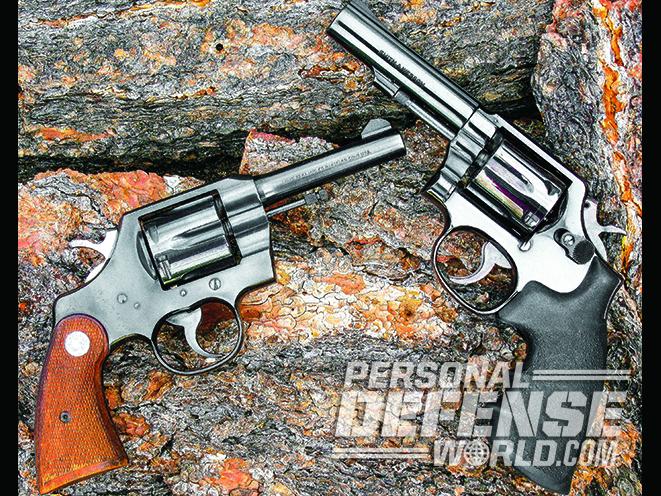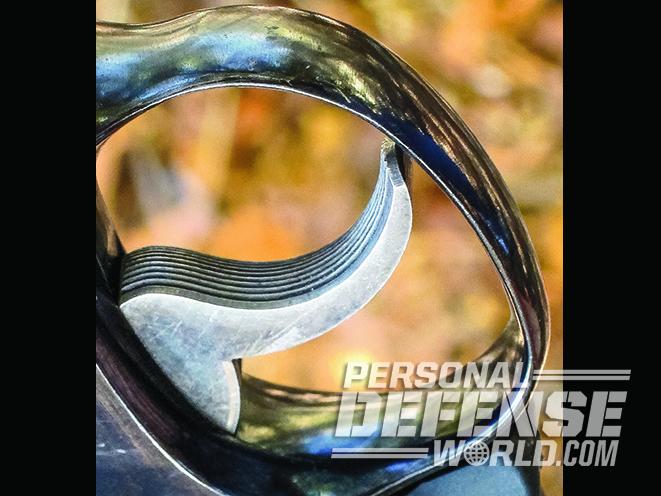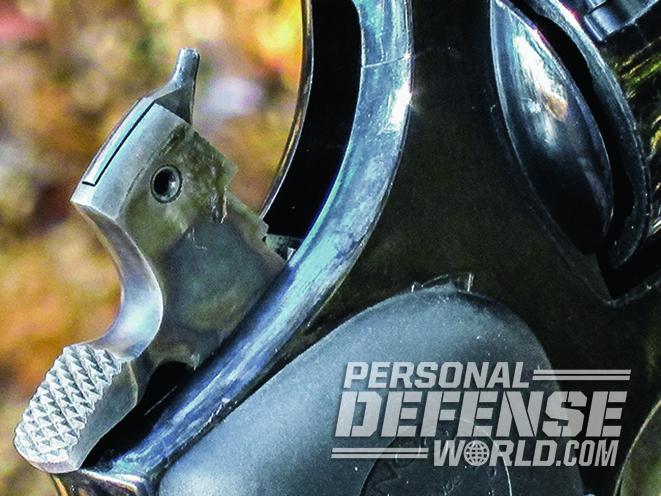For most of a century, the .38 Special ruled the country in terms of sheer numbers of double-action (DA) revolvers sold and carried from coast to coast. More .38 Special revolvers across major and minor brands rode in police holsters than any other caliber during its reign. If regular, everyday folks were inclined to buy a defensive DA revolver in any bore larger than a .22, it was more likely to be a .38 Special than anything else, and the .38 Special topped the list of “Ten Most Popular Handgun Caliber Reloading Die Sales” for over five decades.
Most .38s were built on small- to medium-sized frames convenient for carry without being too bulky or heavy, the caliber was reasonably effective without being obnoxiously loud or hard to handle under recoil, its accuracy was well above average, and the combination of all those attributes in a quality gun made it fairly easy to teach and fairly easy to learn. While the 9mm has almost entirely replaced the .38 in law enforcement, and it’s become the default caliber for a generation raised on autopistols, the humble .38 Special still sells, still shoots well, still remains a favorite among reloaders, and still makes an excellent choice for both defensive and recreational applications. In fact, with today’s advancements in ammunition since the .38 Special was introduced in 1898, it’s even more effective than ever before and has never quite managed to lose its status as the most popular revolver caliber around the globe.
Police Sixguns
Advertisement — Continue Reading Below
Two brands dominated the field of DA/SA revolvers in the U.S.—unchallenged by imports and smaller domestic companies—until Ruger got into the game late in 1972 with its Security-Six line. There were Spanish copies of Smith & Wesson revolvers at greatly varying quality levels and pricing, the occasional imports of other obscure European revolvers, the South American S&W-based Taurus and Rossi revolvers and the inexpensive Saturday Night Special revolvers that came and went very quickly, but none gave Colt or Smith & Wesson any serious competition until Ruger’s products began to establish themselves firmly in the early 1980s. If you happened to be a law enforcement officer between 1920 and 1970, your holster was most likely carrying a Colt or S&W.
Both companies aggressively chased the .38 Special markets—law enforcement and civilian—and both companies offered a good range of models to cover everything from entry level to high-level budgets, and in forms appropriate for duty, plinking and formal target shooting. Until World War II, Colt had the law enforcement world largely sewn up, though S&W more than closed the gap after the war, and while Colt quietly exited DA revolver production years ago, S&W continues to produce several models and two frame sizes in the caliber.
Since police departments who issued them, and individual officers who bought their own, rarely had the funding to buy top-of-the-line models with all the bells, whistles and gold-inlaid engraving, both makers offered basic “service” models with basic features at basic pricing. That usually meant fixed sights, utilitarian finishes, standard narrow hammers and triggers, and relatively small grip panels.
Advertisement — Continue Reading Below
Two of the most popular models in the mid-20th century for uniform use were the Colt Official Police and S&W’s Model 10. Both were “service-grade” revolvers that established excellent reputations for quality where it counted—function and reliability, not looks or features—and both were affordable. Agencies bought them by the thousands, and officers who were either required or allowed to buy their own duty equipment did, too. If there’s a “Cop Gun Hall of Fame” anywhere, you can bet the Official Police and Model 10 were among the first inductees. So let’s take a look at two that rode the river in police leather “back in the old days.”
Colt Official Police

Built on a mid-sized, square-butt frame and introduced in 1927 as a slightly upgraded version of the older Army Special revolver dating back to 1908, the Colt Official Police was manufactured to the tune of over 425,000 units before it was dis-continued in 1969, making it the highest-
volume DA revolver at Colt and one of the most successful handgun models ever produced worldwide. During its long run, it was offered in typical barrel lengths of 4, 5 and 6 inches, and with small service grip panels in checkered walnut (occasionally Colt’s larger target panels), except for a brief fling with Colt’s “Coltwood” plastic panels from 1947 to 1954. Calibers included .22 LR, .32-20, .41 Long Colt and the much more desirable .38 Special. Blued models were the most common, but nickel was available.
Advertisement — Continue Reading Below
- RELATED STORY: Colt Mustang XSP – A Next-Gen Take on the .380 Pocketlite
The Official Police shown here is a six-shot, all-steel, DA/SA revolver in .38 Special with a 4-inch barrel, checkered walnut grips with silver medallions, a narrow serrated hammer and trigger, a serrated ramp front sight, a hammer-mounted firing pin and a clockwise-rotating cylinder. Born in 1963, it was a trade-in gun owned—but never issued or fired—by the Salt Lake City Police Department until it cleared out old armory stock a few years back. Unfortunately, an inventory number was electro-penciled onto the right side, but other than the scuffs and dings acquired during nearly half a century of shelf storage, the sixgun was essentially new when I bought it from the dealer who took it in. The fit and finish on this old Colt reflect a working revolver of the 1960s, when the guns were still hand-fitted, but deep bluing and bright polishing weren’t considered necessary on the model. This Colt was sent off to Grant Cunningham for a tune-up, one of the best mechanics specializing in the older Colt V-spring actions at the time, shortly after I liberated it from the dealer’s showcase.
Like other Colt DA models prior to the Python and later designs, the Official Police has no ejector rod shroud or front cylinder locking system. The crane and cylinder are locked in battery only at the rear, with a single lockup point provided by the cylinder latch pin engaging a recess in the center of the extractor star. While the system works well, the unprotected ejector rod just hanging out there naked and unsupported was a vulnerable point in the Colt design that could (and did) result in a bent rod on occasion if the gun were dropped or used as an impact weapon in a law enforcement role (known as “buffalo-ing” when Wyatt Earp did it) as it was in earlier eras. A secondary issue: If you own or plan to own one and shoot it, keep an eye on the rod’s head. It’s a screwed-on part, and they sometimes tend to loosen and wander off when you’re not looking. Spare parts for these vintage Colts are not easy to come by.
S&W Model 10
Advertisement — Continue Reading Below

Also built on a mid-sized DA frame, the Model 10 roots its ancestry in the .38 Hand Ejector Model of 1899, which was the great-grandpappy of what later became the original M&P family of Smith & Wesson .38s. The Model 10 is also a milestone gun in that it’s the still-in-production descendant of a model design well over 100 years old, with in excess of 6 million variants sold, and arguably the most popular centerfire revolver of the past century. The Hand Ejector series was known by model names prior to 1957, when this K-Frame revolver was officially changed from the .38 M&P to the Model 10.
- RELATED STORY: Classic Snubbies – 3 Iconic S&W J-Frame Revolvers
There have been too many updates and upgrades to go into here during the Model 10’s long production run, but it’s commonly been offered with 2-, 3-, 4-, 5-, and 6-inch barrels, fixed sights, blued and nickel finishes, round- and square-butt grip frames, a variety of wood and synthetic grips of different sizes and configurations, “skinny” (tapered) and heavy barrels, narrow service and wider semi-target hammers, narrow serrated and smooth “combat” triggers, a counterclockwise-rotating cylinder, and in calibers including the .38 Long Colt, .38 S&W, .38 Special and, briefly, the .357 Magnum.
The test Model 10 shown is another personal sample, manufactured in 1979, with a square-butt frame and a blued finish. It originally shipped with a pinned, tapered, 4-inch barrel, but somewhere along the line a previous owner replaced it with a heavy 4-inch barrel. The smaller wooden “service” grips were replaced with a black rubber Hogue Monogrip. Otherwise, with its narrow, casehardened, serrated service trigger and checkered, semi-target hammer, hammer-mounted firing pin, serrated ramp front sight, well-polished steel under its deep bluing, excellent fit and finish, very few signs of use and the traditional S&W two-point cylinder/crane lockup, it’s a good representational sample of the average Model 10 at its best, and no internal work appears to have been done. That dual lockup, incidentally, with its strong cylinder center-pin engagement in the frame’s breech face at the rear and supported by a spring-loaded plunger engaging a recess in the end of the ejector rod up front, protects the rod from impacts and drops reasonably well, even without a full ejector rod shroud.
Advertisement — Continue Reading Below
Back At It

These two old warhorses deserved a good test run, and that meant using five commercial loads. Bullet weights ran from 110 to 158 grains, and I fired each load through both revolvers in SA mode off a rest at 25 yards.
The Colt Official Police was up first, and while normally I’d be reluctant to shoot an un-fired vintage classic, the electro-penciling and scuffs reduced its collector value sufficiently to ease my conscience. Original service grip panels were always too small for me to do my best with in DA shooting, regardless of brand, but in SA mode they weren’t an issue on paper, and the crisp 3-pound SA pull tuned by Cunningham (now retired) was a shining example of what a master could achieve with the old Colt V-spring action. Most of the V-spring’s stacking in DA mode had also been eliminated, as a side note.
Advertisement — Continue Reading Below

The S&W followed, with its factory trigger breaking at 6 pounds with a very clean pull. S&Ws are much easier to tune, and K-Frames like the Model 10 can be extremely slick after a first-rate action job if you feel like spending the money. This one’s entirely passable as it sits, with a smooth DA pull. The larger Hogue grip is at least a couple galaxies beyond the older service grips on the Colt in terms of ergonomics, but in slow-fire SA targeting, it gave the S&W no real advantage. Both sight pictures were equally large and visible, easy to pick up.
The legacy Winchester and Federal American Eagle lead rounds were predictably mild and consistently accurate, and the +P Hornady and Black Hills rounds offered a bit more velocity without producing too much recoil, but the soft-cast, 158-grain, gas-checked lead semi-wadcutter hollow point (LSWCHP) +P from Buffalo Bore stood both revolvers on their heels—literally. These late-era revolvers can safely fire +P ammo if they’re in good condition, but at roughly 1,100 fps through a 4-inch barrel, this Buffalo Bore load doesn’t just push the .38 Special envelope—it shreds it. The Colt particularly liked these rounds, posting the tightest five-shot group of the session at 1.31 inches, and if you want more octane in your .38 than the conventional makers include, Buffalo Bore’s the name to remember.

With the Colt’s legendary “bank vault” lockup that provides a tighter cylinder alignment to the bore at the moment of ignition than the S&W’s action creates, and a lighter trigger, I’d expected the Official Police to take the trophy in this shootout. But the Model 10 beat it with four out of the five test loads, despite the S&W having a trigger pull twice as heavy as the Colt’s. The lead wasn’t all that much, though, and the difference would be largely insignificant anywhere outside the realm of paper punching. Both guns are still entirely viable for mid-bore self-defense and recreation. They’re easy to shoot, and the .38 Special is far from fading away, regardless of the current plastic pistol proliferation. As always, the point of impact varied with bullet weight, so it’s best to check an individual gun with a preferred load to confirm its zero.
Advertisement — Continue Reading Below
- RELATED STORY: 410 Bore Revolvers – 5 Top-Notch ‘Pocket Shotguns’
As a retired revolver-toting cop, working with these two legendary classics was a Sunday drive down Memory Lane. There were six-bangers fancier, more accurate, more powerful and certainly more expensive, but these were the guns that worked the “thin blue line” every day on America’s streets before the semi-auto, the new kid on the block, took over. If you get a chance to shoot one, don’t turn it down. If you get a chance to buy one, crack that wallet open quick, before it gets away. If you inherit one, let your first thought be “Thanks!” not “Pawn shop!” And, if you already own one, at the very least, consider yourself the proud possessor of an important piece of American firearms history.
Colt Official Police
Caliber: .38 Special
Barrel: 4 inches
OA Length: 9.25 inches
Weight: 32 ounces (empty)
Grips: Walnut
Sights: Fixed
Action: DA/SA
Finish: Blued
Capacity: 6
MSRP: N/A
Advertisement — Continue Reading Below
Smith & Wesson Model 10
Caliber: .38 Special
Barrel: 4 inches
OA Length: 9.25 inches
Weight: 34.5 ounces (empty)
Grip: Rubber
Sights: Fixed
Action: DA/SA
Finish: Blued
Capacity: 6
MSRP: N/A
For More Information
Colt
colt.com; 800-962-2658
Smith & Wesson
smith-wesson.com; 800-331-0852
This article was originally published in ‘The Complete Book of Revolvers’ 2017. To subscribe, visit http://outdoorgroupstore.com



































